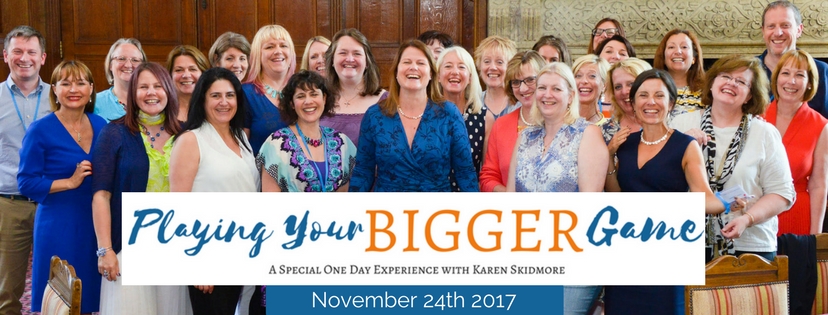
Marketing live events in this digital age?
Marketing live events in this digital age?
I’ve gone back to marketing live in-person events again. After a three year run of being totally digital, I’ve realised how much I missed running them and how important they are to a business like mine; a business that needs me to show up and be visible.
Perhaps you’re the same? It’s your expertise or special ninja skills that your clients are buying.
Access to easy to use and cheaper tech tools have meant that more expert-led businesses have been able to switch to running events online. Webinars and teleseminars were only for the technically savvy 5 or 6 years ago. But now, platforms such as Facebook and Zoom have made it cheaper and easier than ever to run a virtual event, whether that’s a full presentation style webinar or regular live video broadcasts from your phone.
Going virtual has also made global collaboration easier than ever; there’s no need to jump on a plane, train or automobile to reach audiences on their own turf. I’ve never been part of that international speaking circuit where it may be a different city every night but I’ve heard enough of the stories to know travel isn’t as glamorous as you may see it on Instagram.
I used to run half-day workshops every eight weeks in my early years. Back in 2005 through to 2007, these training events where the backbone to my marketing strategy. I sold low priced tickets – between £50 to £75 – and filled each event with 15 to 20 people. And each event would give me three or more people upgrade to become private coaching clients.
Those Business Forum events were instrumental in creating a steady £40,000 annual revenue, whilst working part time, term time when my kids were in junior school.
But my Achilles Heel, boredom, kicked in and I wanted to do something new and different so started to go more online. It was those early days of digital marketing and my love of teleseminars led me to run webinars and taking my training online through group programmes and my membership club, Web Tech Club.
I carried on and ran the odd live event here and there. Web Tech Live one day events proved popular and I ran one programme, Profitable Products, as a mix of virtual training and live workshop.
But setting up, promoting and running live events got to be knackering for me because I was trying to do much of it by myself and often on a tight budget. The shiny shiny lights of digital marketing called to me and I got really seriously stuck into running online training sessions. From 2013 through to 2015, I spent a lot of time working on my webinar marketing system. And I got it working really well. It almost feels effortless to set up, promote and run a webinar now.
So why live events now … in this digital age?
Why go to all the effort, time and expense to run a live, in-person event when you can simply stay at home, in your slippers?
The truth is that this digital age isn’t quite what it’s cracked up to be anymore, compared to a year ago.
When we first started to see digital marketing opening up opportunities for our businesses four or five years ago, tech was fast to become accessible to everyone; you no longer had to a be tech person to get going. However, these past 18 months has seen this accessibility to digital marketing has meant big changes for businesses like mine and yours.
Whatever audience you are looking to attract, your marketplace probably feels very saturated now. It’s now very easy to create a gorgeous website, beautifully branded with incredible photography and have a marketing funnel that – on the outside – looks like it’s effortlessly bringing in leads and converting them to sales. Costs for business online set up have significantly dropped and it really doesn’t take much for a non-tech person to do a lot of themselves now.
However, that’s only part of the shit-mix that is being stirred up. Your biggest competitors are not any of these new pop-up businesses.
Your biggest competitors are time and attention.
Noise levels are now at an all-time high on each and every social media platform and don’t show any signs of quieting down. We are seeing trends that people are starting to request phones. Yup, phones that just call and text people; no apps, no internet access, no location tracking.
At the time of writing this, the new iPhone 8 and X are due out soon and there are signs that the marketplace is starting to say “How much?” Even the most avid iPhone user is showing that they may quite happy to stick with their 6 because they didn’t upgrade to their 7 and just can’t get their head around the fact that they could be spending more on a phone than they would their next holiday!
People are getting overwhelmed with how much information out there and are now – thank goodness! – becoming savvier in self-curating what they receive. From taking control of their Facebook newsfeed and blocking ads through to timers that lock down your app access during core hours.
Yes, I grant you, I don’t see this happening with my 17YO daughter yet LOL but there are more people now – your customers, perhaps? – beginning to realise that they can take control of the tidal wave of content that washes over them if they let themselves get sucked in.
Your content – blogs, emails, posts and photos – is now competing with millions of articles, videos, Facebook Lives and photos. So when it comes to marketing your next virtual event, it’s easy to see how your promotion just gets swallowed up in the sinkhole of online content.
And let’s not forget that that Facebook advertising, that may have been free-flowing leads for you a year ago, is now swamped with advertisers all wanting a piece of the gold land. It’s not surprising that your simple promoted ads a year ago, just don’t seem to get results this year. Facebook has their pick of their own customers now so keep in mind that your £100 budget may not worthy of their algorithm anymore.
So getting back to the topic of this article; why live events in this digital age?
There are lots of good reasons NOT to run live, in-person events. They aren’t necessarily any easier to promote because let’s get really clear … there are NO magic pills to swallow. Sorry, not sorry … let’s get real about your marketing right now.
So although I’d love you to take away that live events could be something for you to work on in your business, I also don’t want to sell this as the “easy option”.
1) Time
You need time to run a live event successfully. Not just in the promoting but also in the planning. So if you are in digital mindset, which means that you could decide to run a webinar in just 2 or 3 weeks time, remember your live event is going to need that in months … not weeks. If you haven’t run a live event before, I would recommend you need a minimum 3 months, ideally 4 or 5.
2) Money
Yes, you can do a live event on the cheap but I really wouldn’t recommend it. There’s no doubt you could book up your local community centre (or even a training room in a nail bar … that was the venue of my first event in 2004!!) but you have to consider your audience’s expectations and the value of the content you are delivering. There are all sorts of things that can suck money from you, from printed workbooks through to hiring an events coordinator to help you out on the day, so be prepared and get realistic about how much money you’ve got put aside before jumping in.
There are all sorts of things that can suck money from you, from printed workbooks through to hiring an events coordinator to help you out on the day, so be prepared and get realistic about how much money you’ve got put aside before jumping in.
3) Bigger vision
What is the reason you want to run a live event? Where are you leading your customers next? If your live event is the end point, you’re probably missing a huge opportunity. To see the true benefit of a live event, have the next step for your attendees to take after spending the day or weekend with you.
Whether you run an event as a low-priced event that you use to build trust and engagement to allow you to offer the bigger ticket programme or product on the day, or you sell a higher ticket price and run it as standalone event that flows into a longer-term solution, your event has far greater potential to grow your business being a lead-in for your core offer. Events can be a profitable revenue stream but think beyond them being your main tributary.
4) Support
You can’t run a live event by yourself. At a minimum, you need one virtual assistant or event administrator who can help with bookings and liaison with the venue. You need someone with an eye for detail who can organise and see what you’re missing (because you will … that’s always going to be the case!), whilst you do your “thing”. If you try to be the promoter, creator of content, workshop leader and organiser of refreshments, you will run yourself ragged and miss out on the potential of using your event to grow you and your business.
Have I put you off yet?
Now the great thing about this list is that is going to put a lot of people off running events. And that really is great news!
You see, running events aren’t the easy option so there are going to be a lot of people – your competitors, hopefully – who throw their hands up in the air as they see the work, time and effort needed and stick to the digital ways of doing things.
But digital is where all the noise is at.
Yes, I will be continuing to run my webinars for the foreseeable future. I love running them and they are easy for me to set up and promote right now. And I know how much value my subscribers and clients get from them. So this is not a case of “either or”.
But as I’ve shared here, we need to wake up and do things differently. We need to find ways of connecting with our customers and clients as humans, get out from behind our screens and let them see the whites of our eyes again.
Live events are NOT magic pills. And yes, you will be using digital marketing to promote them. But they sure are an incredible opportunity to stand out and be counted right now.
And that’s why I’m doing live events in this digital age.
Who’s with me?












